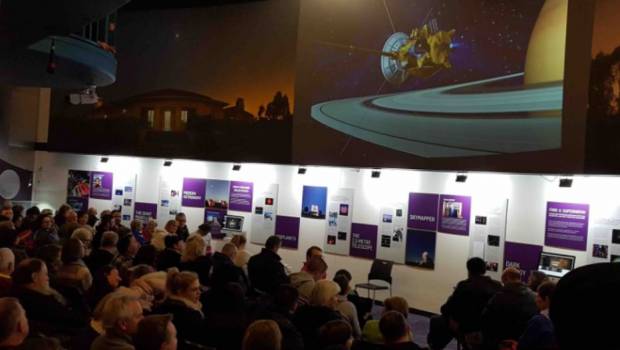Mt Stromlo projects Cassini Saturn crash with Epson
SYDNEY, 13 February 2018 – Mt Stromlo Observatory has been in operation for over 100 years – from studying the Sun to discovering what most of the Universe is made up of. In 2003, most of the Observatory was destroyed in the Canberra bushfires and the visitor centre was closed. In 2015, Dr. Brad Tucker launched a quest to rebuild the Visitor Centre and for that, in part, he turned to Epson and their projectors.
Tucker explained, “The project involved completing the rebuilding from the fire damage, creating a space to host the public and showcase the great work we are doing. As part of the project, I wanted to be able have the functionally to display projections that we have created – travelling around Mars and through space, the ability to show 3D visualisations of our research and also a high-quality projector for showing our great images and hosting the public for talks and events. A projector this versatile and one that would also have enough resolution to be visible with lights and other displays on had to be good and to find it I reached out to Epson.”
The Epson team helped Tucker find the best projectors and integrated them as part of a sponsorship program. Currently Mt Stromlo Observatory uses a range of Epson G-series projectors.
Tucker continued, “Upon learning our requirements of what we wanted it for, and our budget, Epson put together a recommendation and package that we could afford and use. They could have supplied lower quality and cheaper models, but they did not want us to compromise on quality or have our images suffer.”
During the winter months Mt Stromlo Observatory runs monthly public nights where the public comes up for stargazing and talks inside the visitor centre, also now seen via Epson projectors.
Tucker added, “We get around 1,000 – 1,200 people for each public night. Two different Noble Prize winners have used the Epson projectors, we have also shown a movie about the deployment of NASA’s new James Webb Telescope and even the scientists behind the movie Interstellar showed how they created the visualisations for the movie on our Epson projectors. You do not want something like Interstellar to be shown on a low-resolution projector – this is why the Epson projectors are perfect for the job.”
Earlier this year, the observatory started planning for the end of the Cassini–Huygens mission, commonly called Cassini, a collaboration between NASA, the European Space Agency, and the Italian Space Agency to send a probe to study the planet Saturn and its system, including its rings and natural satellites.
Tucker continued, “The issue we kept running into was that too many people wanted to attend and we could not fit them all inside. At the same time, we were in discussion with Epson about a permanent outside projection solution on the Particle Physics tower at the main ANU campus. After those tests, I realised the perfect solution for the end of Cassini was an outside projection on our large telescope dome. Once again Epson without hesitation offered to bring down their EB-L25000UNL 25,000 lumens laser projector capable of projecting on a 50 square meter curved dome so all attendees could see the end of Cassini. It was this that allowed us to share with the public the final moments of the mission as it crashed into Saturn. We also streamed it inside on one of our Epson G-series projectors.”
Dr. Brad Tucker is clearly passionate about his work and the work of Mt Stromlo Observatory, a passion that also extends to his Epson projectors. He concluded, “Epson not only has appreciated the need to showcase images and visualisations with excellent resolution, they understand that research, education, and engaging with the public are important aspects and are willing to help. Not many companies do that nowadays.”







